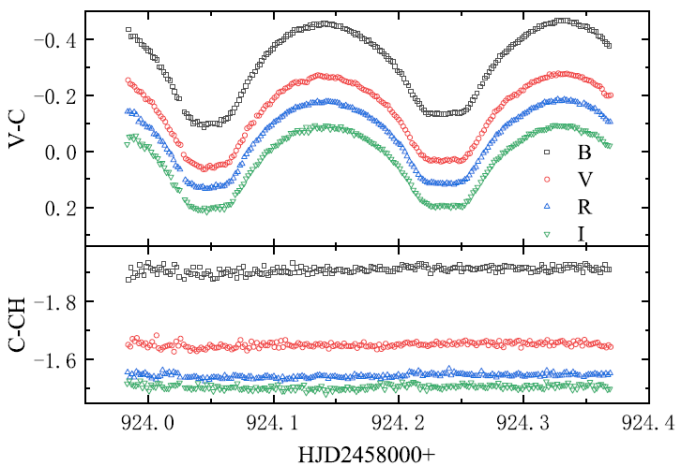Recently, Shuyue Zheng, a 2018 undergraduate student from School of Space Science and Physics published a research paper entitled "The first photometric and spectroscopic analysis of the extremely low mass-ratio contact binary NSVS 5029961" in the authoritative astronomical journalMonthly Notices of the Royal Astronomical Societyunder the guidance of Kai Li who is a teacher of this school. Shandong University is the unique completion unit of the paper.
More than 50% of the stars in the universe are in binary or multi-star systems, so the study of binaries is of great significance.A contact binary is a strongly interacting binary system in which two components are contact with each other and share a common envelope. The formation, evolution and activity of contact binaries have always been unsolved issues in astrophysics. In this paper, the contact binary NSVS5029961 was observed by Weihai Observatory 1.0-m telescope of Shandong University (WHOT). Combining with the sky survey data of TESS, NSVS, SuperWASP and ASAS-SN, and using the spectral data taken by Guo Shoujing Telescope (LAMOST), we analyzed this target for the first time. The results show that NSVS5029961 is a shallow contact binary with an extremely low mass ratio (mass ratio is 0.15 and contact degree is 19%). This result increases the sample number of extremely low mass ratio contact binaries and is of great significance for studying the mass ratio cut-off of contact binaries. We also studied the chromospheric activity, evolutionary state and dynamical stability of NSVS5029961, and concluded that it should be formed from a low mass ratio short period detached binary by the orbital angular momentum loss caused by magnetic braking and Case A type mass transfer. These results promote the study of the formation, evolution and activity of contact binaries.

The light curve of NSVS5029961 observed by WHOT
School of Space Science and Physics attaches great importance to the cultivation of undergraduates’ scientific research and innovation ability, actively promotes scientific research activities such as scientific research projects, and implements the reform of the four-year undergraduate tutorial system.This school has established a collaborative training mechanism for the integration of science and education and mutual promotion, and encourages students to participate in scientific research activities, and creates an environment for undergraduates to participate in scientific research and supports the training of high-quality undergraduate talents with high-level scientific research.At the same time, this school actively organized students to participate in all kinds of competitions and scientific and technological innovation activities, such as Challenge Cup, Physical Science and Technology Innovation Competition, so as to comprehensively improve students' personal quality and cultivate students' innovative ability.
The work is supported by the National Natural Science Foundation of China, Young Scholars Program of Shandong University, Weihai, and the Supercomputing Center of Shandong University, Weihai.Monthly Notices of the Royal Astronomical Societyis a journal sponsored by the Royal Astronomical Society. It has a history of nearly 200 years and is one of the top academic journals in the field of astronomy and astrophysics. The impact factor of this journal in 2020 is 5.23.
Article link:https://doi.org/10.1093/mnras/stab1829